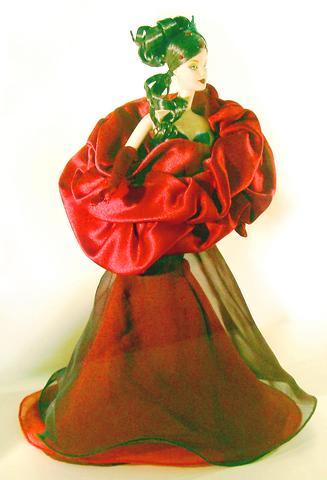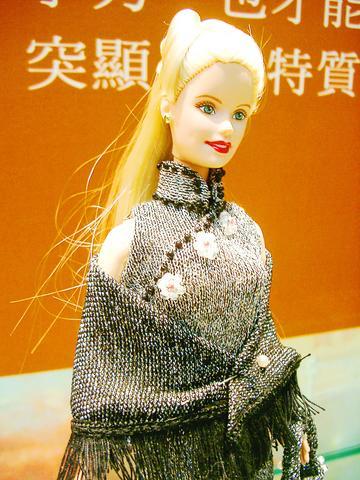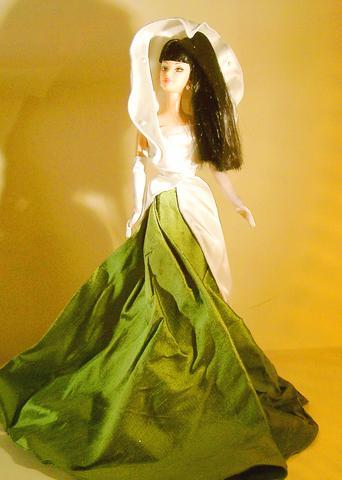I'm a Barbie girl, in a Barbie world. Life is plastic. It's fantastic!"
Twenty years ago, Lin Ah-ching (
From 1967 to 1987, Taishan was home to the flagship factory of Mattel Ltd, producing Barbie dolls for the world. Each day the factory produced 50,000 to 60,000 doll heads. Lin was one of the 8,000 workers who worked in this small semi-industrial township.

PHOTO: YU SEN-LUN, TAIPEI TIMES
Following the opening of Taiwan's first Doll Museum last month, the little-known past of Taishan has come into the spotlight again.
"Look, this part of her body is made by the revolving machine. And for the hair, we had to sew the hair circles then use ovens to make [the hair] curl," Lin said, pointing to a doll in the museum and recounting her 20 years of making Barbies.
Lin said she originally worked in a clothing factory in Taoyuan and in 1967, Mattel set up and she moved to Taishan to become one of the earliest employees in the factory.

The business soon took off and peaked in the 1980s. The factory was divided into many departments that included body-shaping, spray-painting, hair-implants and sewing.
"For example,
Barbie's eyes, eyebrows, cheeks and lips, and also Ken's hair, are all made by spray paint," Lin said.

Teng Cheng-ming (
Mattel in Taiwan was a joint venture between Mattel and Hua-hsia Plastic (
"In the beginning, it was very primitive. There was no machine for us to curl the hair. We had to use chopsticks and wire to roll up the hair and use rice cookers to steam it. But you could not steam too much or it would damage and blur the paint for the doll's eyes," Lin said.
The factory became so busy, the work needed to be contracted out to workers outside of the factory. Thousands of housewives took up the piece-work jobs, doing knots, sewing buttons and laces, or putting on little shoes and earrings for the dolls.
Ku Tsuei-eh (
Ku said she if worked hard, she earned NT$360 a day. At that time, Lin Ah-ching's salary was NT$700 a month. A Barbie doll, however, cost NT$1,200. In today's NT dollars, that works out to more than the price of a Louis Vuitton bag.
Factory community
It was, therefore, common for the employees to take home a Barbie doll. "People would think you were weird if you didn't take one home," Lin said.
Some would hide the doll in their bell-bottomed pants. Others took hands and legs in their underwear to assemble at home.
This made the company hire security. "Whenever security showed up, workers would give signals to each other and some had to throw away the dolls out into the rice fields. Sometimes they threw them into people's houses," Ku said.
Of course, workers caught carrying a doll home were sacked immediately. Generally, according to Teng, also a labor-union member at Mattel, the company treated its employees fairly well.
"The company put in plenty of employee-welfare funds. We ate well and had parties in the factory. It was like a big family. We dated the girls and got married here," said Teng, whose wife was also a Mattel employee.
In 1984, employees were informed that the factory would move its operations to Indonesia and China and the factory closed in 1987. There were no disputes or fights from the labor side, as the union negotiated a severance fee with the management.
Each worker was paid between NT$100,000 and NT$200,000. But the local economy suffered.
Ku Tsuei-eh now serves in the Taishan Township Office and Community Rebuilding Team. He was one of those behind the setting up of the doll museum. The museum now displays 400 differently clad Barbie dolls, as well as antiques and photos of the history of Mattel in Taiwan.
"The doll-making was a major part of Taishan Township. So we want to restore doll-making culture in this town," Ku said.
In the past five years of preparing the doll museum, the team set up workshops for Taishan residents to learn designing and making clothes for Barbie dolls. The workshop also invited old employees, such as Lin and Teng, to talk about their experiences.
Recounting her days at Mattel, Lin Ah-ching feels that living in Barbie's world was accidental but nice.
"It was all about making a living. I was never a big fan of dolls and I never had the luxury of collecting them. But I know how to make a perfect doll," she said.
For your information :
Taishan Doll Museum: 26, Lane 26 Fengchiang Road, Taishan, Taipei County (
Telephone: (02) 8531 1406

That US assistance was a model for Taiwan’s spectacular development success was early recognized by policymakers and analysts. In a report to the US Congress for the fiscal year 1962, former President John F. Kennedy noted Taiwan’s “rapid economic growth,” was “producing a substantial net gain in living.” Kennedy had a stake in Taiwan’s achievements and the US’ official development assistance (ODA) in general: In September 1961, his entreaty to make the 1960s a “decade of development,” and an accompanying proposal for dedicated legislation to this end, had been formalized by congressional passage of the Foreign Assistance Act. Two

March 31 to April 6 On May 13, 1950, National Taiwan University Hospital otolaryngologist Su You-peng (蘇友鵬) was summoned to the director’s office. He thought someone had complained about him practicing the violin at night, but when he entered the room, he knew something was terribly wrong. He saw several burly men who appeared to be government secret agents, and three other resident doctors: internist Hsu Chiang (許強), dermatologist Hu Pao-chen (胡寶珍) and ophthalmologist Hu Hsin-lin (胡鑫麟). They were handcuffed, herded onto two jeeps and taken to the Secrecy Bureau (保密局) for questioning. Su was still in his doctor’s robes at

Last week the Democratic Progressive Party (DPP) said that the budget cuts voted for by the China-aligned parties in the legislature, are intended to force the DPP to hike electricity rates. The public would then blame it for the rate hike. It’s fairly clear that the first part of that is correct. Slashing the budget of state-run Taiwan Power Co (Taipower, 台電) is a move intended to cause discontent with the DPP when electricity rates go up. Taipower’s debt, NT$422.9 billion (US$12.78 billion), is one of the numerous permanent crises created by the nation’s construction-industrial state and the developmentalist mentality it

Experts say that the devastating earthquake in Myanmar on Friday was likely the strongest to hit the country in decades, with disaster modeling suggesting thousands could be dead. Automatic assessments from the US Geological Survey (USGS) said the shallow 7.7-magnitude quake northwest of the central Myanmar city of Sagaing triggered a red alert for shaking-related fatalities and economic losses. “High casualties and extensive damage are probable and the disaster is likely widespread,” it said, locating the epicentre near the central Myanmar city of Mandalay, home to more than a million people. Myanmar’s ruling junta said on Saturday morning that the number killed had